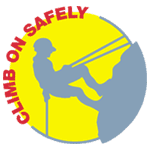Scouting and Climbing
Background
During the summer of 1995, youth participants in the National Junior Leader Instructor Camp held at Philmont Scout Ranch identified climbing as an increasingly popular activity. They requested the development of program literature by the Boy Scouts of America in support of climbing. In May 1997, the first edition of the Climbing merit badge pamphlet was released and proved to be extremely popular.
In September 1997, a national climbing task force was organized, and members met for the first time to discuss suggestions they received regarding climbing techniques and appropriate safety measures. Their vision was to develop climbing literature and training for units and councils. As a result, Climb On Safely was developed and made available in fall 1998. Similar to Safe Swim Defense and Safety Afloat, Climb On Safely is designed to orient adult leaders with the proper procedure for organizing and managing BSA climbing/rappelling activities for their units.
In the two years following Climb On Safelyıs introduction, the climbing task force developed additional materials for use by Scouts and leaders. These included the Climb On Safely Training Outline, a revised Climbing merit badge pamphlet, Climbing/Rappelling National Standards, Topping Out: A BSA Climbing/Rappelling Manual, and a Climbing Lesson Plan for a new Climbing section at National Camping School.
Climb On Safely
Designed for unit climbing/rappelling, Climb On Safely (No. 20-099) is the BSA's recommended procedure for organizing and managing climbing and rappelling activities at all levels of the Scouting program: Tiger Cubs BSA, Cub Scouting, Webelos Scouting, Boy Scouting, Varsity Scouting, and Venturing. It offers guidance for climbing and rappelling at national sites and at specifically designed facilities, including climbing towers and fixed and portable walls. Climb On Safely has eight points to help ensure the safety and well-being of participants.

- Qualified Supervision
- Qualified Instructors
- Physical Fitness
- Safe Area
- Equipment
- Planning
- Environmental Conditions
- Discipline
Climb On Safely is not designed to prepare leaders to instruct BSA youth in the skills of climbing or rappelling. Teaching climbing or rappelling requires a trained climbing instructor who meets the criteria defined in Climb On Safely.
Climb on Safely Training Outline
The Climb On Safely Training Outline (No. 20-101) is designed to teach adult Scouters how to implement the eight points of Climb On Safely for unit climbing/rappelling activities. This orientation can be conducted by anyone who has an interest in climbing or rappelling; it does not require a skilled climber or rappeller. Training in Climb on Safely takes about 40 minutes and can be done at a roundtable or summer camp or in conjunction with other unit leader training.
Climbing Merit Badge
The Climbing merit badge (No. 10522) is an optional merit badge that a Scout may earn toward the attainment of the Star, Life, and Eagle ranks, as well as for Eagle Palms. While the requirements for the Climbing merit badge have not changed since its introduction in 1996, the contents of the Climbing merit badge pamphlet (No. 35001A) have changed significantly in the 2000 edition. Photographs and illustrations depict climbing/rappelling techniques recommended by the Boy Scouts of America.
Topping Out
Topping Out: A BSA Climbing/Rappelling Manual (No. 3207) describes and illustrates the climbing and rappelling techniques recommended by the Boy Scouts of America. Where appropriate, several alternative techniques are covered. The recommendations in Topping Out supersede those in all previous BSA publications. Topping Out is designed as a resource to guide BSA climbing directors and instructors in teaching others proper bouldering, climbing, rappelling, and anchoring procedures and techniques. It is an appropriate resource for all BSA climbing/rappelling activities wherever they are conducted.
Climbing/Rappelling National Standards
The current year Climbing/Rappelling National Standards apply to all council and district climbing/rappelling activities where multiple units participate. Climbing/rappelling activities include climbing/rappelling towers, vertical walls, horizontal walls, bouldering, and related programs. Programs that operate one week or more are required to be visited beginning January 1, 2001. A Project COPE or climbing inspector is empowered to visit the climbing/rappelling program and make recommendations to the councils.
National Camping School Climbing Section
Beginning in 2000, each region will offer at least two weeklong climbing sections at National Camping School. Participants who successfully complete this section will be issued a certificate of completion of training as a BSA climbing director. A climbing director must be at least 21 years of age. Over a period of at least three days, climbing directors are empowered to train BSA climbing instructors who are at least 18 years of age.
A BSA climbing director or BSA climbing instructor who is at least 21 years of age must supervise the BSA climbing/rappelling site. A minimum of two BSA climbing directors and/or BSA climbing instructors must be present during the operation of any BSA climbing or rappelling activity. Each BSA climbing director or BSA climbing instructor supervises no more than six participants, including adult leaders, in climbing or rappelling. Until January 1, 2002, a Project COPE director or instructor may serve as a BSA climbing director.